Olympus DLX IS-10, IS-10 User Manual

INSTRUCTIONS
Before using your camera, read this manual carefully to ensure correct use.
We recommend that you take test shots to get accustomed to your camera before taking important photographs.
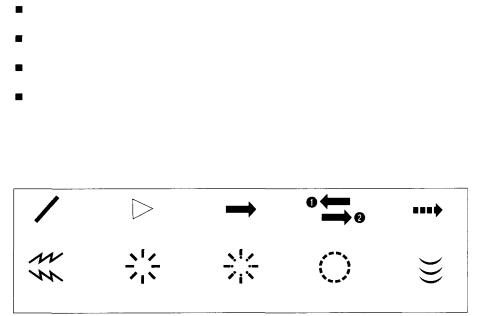
Thank you for purchasing an Olympus camera.
MAIN FEATURES
Built-in 28mm~110mm approx. 4X zoom lens for increased shooting range.
SLR lens ensures that what you see in the viewfinder is what you get on film.
Direct Mode Select buttons let you easily select the right exposure mode for any shooting purpose.
Optional remote control to operate the camera from a distance.
Symbols used in this manual:
Incorrect |
Order |
Manual |
Operation |
Automatic |
|
|
operation |
order |
operation |
Beep |
Indicator on |
Indicator |
Attention |
Depress |
|
|
blinking |
|
halfway |
2

PREPARATIONS
Names and functions of parts |
4 |
Outline of operations |
10 |
Viewfinder display |
6 |
Loading the batteries |
12 |
LCD panel |
7 |
Checking the batteries |
13 |
Diopteradjustment |
8 |
Points to remember |
14 |
Using the strap/optional soft case |
9 |
|
|
Loadingthefilm |
16 |
BASIC OPERATIONS Taking pictures |
18 |
Unloadingthefilm |
21 |
ADDITIONAL FUNCTIONS
Using the focus lock |
22 |
Restoring the standard |
|
Flash photography |
23 |
shooting mode |
36 |
Selftimer |
29 |
Spot metering |
37 |
Using the exposure modes |
30 |
Remote control (optional) |
39 |
TAKING BETTER PICTURES
Effects of zoom and its advantages 41 Autofocus (AF)
41 Autofocus (AF) 43 Exposure
43 Exposure  45 Film speed
45 Film speed  46 Metering the amount of light
46 Metering the amount of light  47 Accessories (optional)
47 Accessories (optional)  48
48
CAMERA MAINTENANCE
Care and storage |
49 |
|
Battery handling |
49 |
|
Troubleshooting |
50 |
|
Questions and answers |
53 |
|
Specifications |
54 |
3 |
|
|
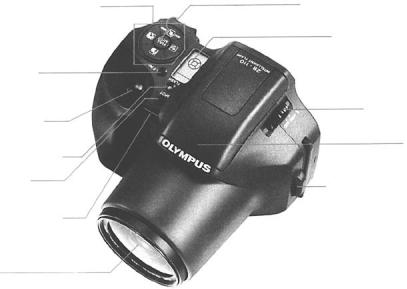
PREPARATIONS
NAMES AND FUNCTIONS OF PARTS
Direct Mode Select buttons (See p. 30.)
Selects exposure modes: Stop Action, Portrait, Landscape, and Night Scene.
F. No. button (See p. 35.)
Sets the aperture in the Aperture-Preferred mode.
Shutter release button
Flash mode button
Spot button (See p. 37.)
Self timer indicator
(See p. 29)
Remote control sensor (See p. 39.)
Full-auto button (See p. 36.)
Restores the Standard-Shooting mode.
LCD panel (See p. 7.)
Power switch/
Flash release
Flash
Strap attachment stud
Lens
4
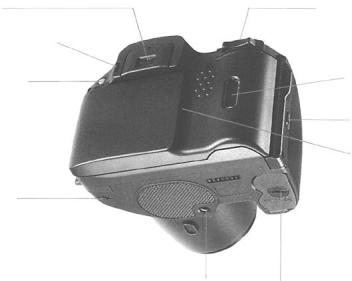
Viewfinder
(See p. 6.)
Diopter adjustment dial
Selftimer/remote
control button
Mid-roll rewind button
Zoom (T/W) buttons (See p. 18.)
Film window
For confirmation of film ISO speed
Back cover release
Back cover
Tripod socket Battery compartment cover
5

VIEWFINDER DISPLAY
Autofocus frame
Position your subject within the autofocus frame.
Spot frame
For spot metering, position the subject within the spot frame.
Flash
Autofocus
Lights when the subject is in focus.
Overexposure/
Underexposure
(p. 35)
6
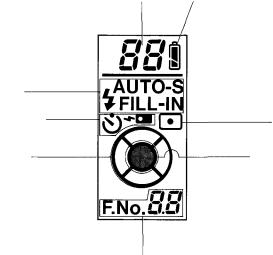
LCD PANEL
Exposure counter (p. 17) |
Battery check (p. 13) |
Flash modes (p. 23)
Self-timer/remote control
(p. 29/39)
Mode status indicator
(p. 30)
Displays the engaged exposure mode by showing the corresponding area.
Spot mode (p. 37)
Full-Auto mode (p. 36)
The camera does everything automatically in this mode.
Aperture setting (p. 35)
7

DIOPTER ADJUSTMENT
To Adjust the Viewfinder to CompensateforNearandFarsightedVision.
Turn the diopter adjustment dial until the viewfinder display becomes clear.
Turn up if you are nearsighted or down if you are farsighted.
8
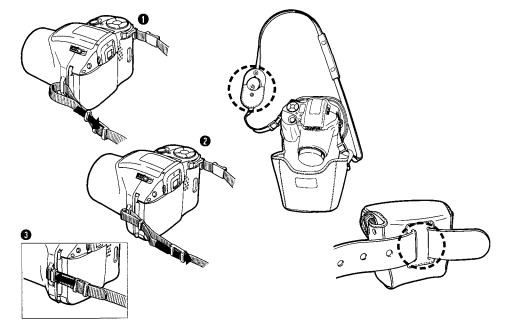
USING THE STRAP/OPTIONAL SOFT CASE
Theoptional remote control's case can be attached to the strap.
The soft case can be attached to
a belt with the belt loop. |
9 |
|
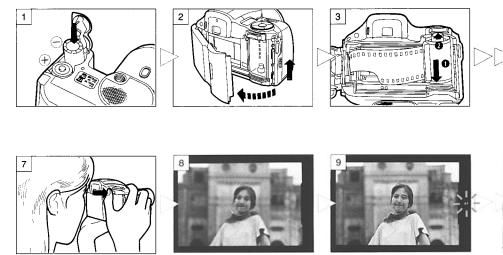
OUTLINE OF OPERATIONS
Basic Shooting Procedures
Load the batteries (p. 12). |
Open the back cover (p. 16). |
Load the film (p. 16). |
Press the zoom buttons to determine the composition (p. 18).
Place the autofocus frame on the subject you want to focus on
(p.19).
Depress the shutter release button halfway, making sure the autofocus indicator in the viewfinder lights and the autofocus beep is heard (p. 20).
10
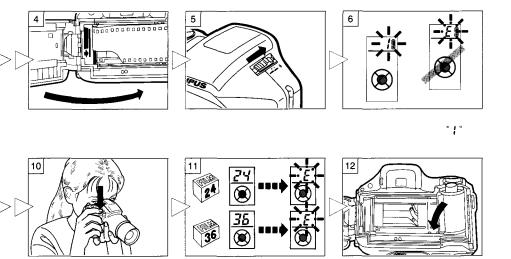
Close the back cover (p. 17). |
Turn the power switch ON |
|
(p. 17). |
Depress the shutter release |
When the film reaches the end, it |
button fully to take a picture |
will automatically rewind (p. 21). |
(p. 20). |
|
Make sure the exposure counter on the LCD panel reads
(p. 17).
Open the back cover to remove the rewound film (p. 21).
11

LOADING THE BATTERIES
Use two 3V lithium batteries (CR123A or DL123A).
Turn the lock screw to OPEN |
Insert the batteries. And |
with a coin. Place your |
close the cover. Turnthe |
fingertip in the notch. And |
lock screw to CLOSE. |
open the battery cover. |
|
 When replacing the batteries, make sure to turn the power switch OFF before unloading the batteries.
When replacing the batteries, make sure to turn the power switch OFF before unloading the batteries.
 Align the (+) and (-) directions of the batteries correctly as shown.
Align the (+) and (-) directions of the batteries correctly as shown.
Read "Battery Handling" on page 49.
12

CHECKINGTHEBATTERIES
Turn the power switch
ON. Be sure to check the batteries as well.
Display |
Meaning |
|
|
|
|
lights (turns off |
Batteries are OK. |
|
after 12 sec.). |
You can shoot. |
|
|
|
|
blinks and other |
Batteries are low |
|
and should be |
||
indicators on the |
||
replaced. |
||
LCD panel are |
||
|
||
displayed normally. |
|
|
blinks and other |
Batteries are dead |
|
and should be |
||
indicators on the |
||
replaced |
||
LCD panel go out. |
||
immediately. |
||
|
||
|
|
Keep spare batteries on hand when going on a long trip or when using the camera in cold weather.
13
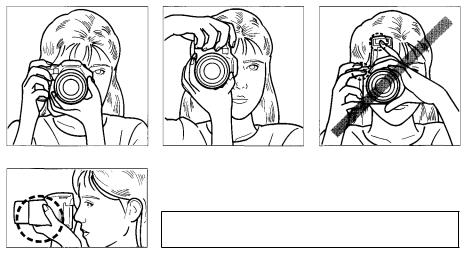
POINTS TO REMEMBER
Hold the Camera Correctly.
Correct. |
Correct. |
Incorrect. |
Note: As the focal length becomes larger, shaking the camera becomes more noticeable. Hold the camera firmly with both hands while keeping elbows at sides to prevent the camera from shaking.
Cautions:
 Try not to hold the lens barrel.
Try not to hold the lens barrel.
 Keep your fingers away from the lens and flash.
Keep your fingers away from the lens and flash.
14

Proper Shutter Release. The shutter release button has two clicks. Practice before loading the film.
Keep the shutter |
Depress the |
|
release button |
shutter release |
|
depressed halfway. |
button fully. |
|
|
|
|
|
|
Cautions: |
|
|
• |
|
|
Press the shutter release |
|
|
button gently. |
|
|
• |
|
|
Avoid shaking the |
|
|
camera when pressing |
|
|
the shutter release button |
|
|
to prevent blurry pictures. |
To lock the focus. |
|
|
To release the |
||
|
shutter and take |
|
Make sure |
the picture. |
|
The image is clear, the |
Note: When the autofocus |
|
autofocus beep is heard, |
indicator is blinking, the |
|
and the autofocus indicator |
shutter won't release. |
|
lights in the viewfinder. |
(See p. 43.) |
|
15
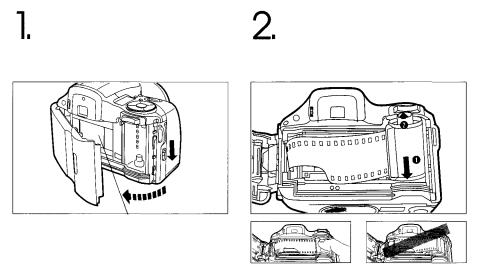
BASIC OPERATIONS
LOADINGTHEFILM
Slide the back cover |
Load the film. |
release upward to open |
|
the back cover. |
|
Shutter curtains
Caution: Do not touch the shutter curtain, and do not press it with the
edge of film. |
Note: Make sure the film is lying flat. |
|
16
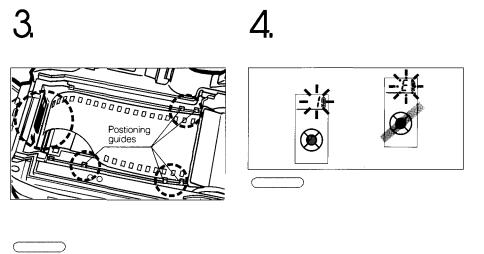
Align the tip of the film leader with the mark as shown, and close the back cover.
The film automatically advances to the first frame.
Make sure
The film does not overlap any of the positioning guides shown above.
Turn the power switch ON.
Make sure
The exposure counter on the LCD panel reads  .
.
Note:
If  blinks in the exposure counter, as shown above, reload the film.
blinks in the exposure counter, as shown above, reload the film.
17
